The MGA With An Attitude
STEERING ARM and SWIVEL PIN Replacement - FS-111
For general maintenance or overhaul of the front suspension, the steering arm and swivel pin commonly do not need to be disassembled from the knuckle. However, with age and abuse or failed seals, the swivel pin threads may be corroded, or the swivel pin may be bent. On more rare occasion there may be a bent steering arm. If a bent swivel pin is otherwise in good condition it may be possible to straighten it without removing it from the knuckle.
It is fairly common to skid into a curb on wet pavement and bend a swivel pin or steering arm. If the steering lever or swivel pin may need to be removed, you can count on them bring very secure and requiring much force and/or heat for disassembly. To remove the steering arm, screw the nut on flush with end of thread, clamp the knuckle in a vise, and heat the knuckle at the thinnest point near the hole for the steering arm. Heat to dull red, then tap the nut with a heavy hammer to remove the arm.

There are three different knuckles and four different steering arms for MGA.
The earliest steering arm has smaller nut and smaller diameter taper. The knuckle may be reamed to larger diameter taper and re-cut the keyway to install a later steering arm. Otherwise the parts need to be used as matched sets with part numbers shown in the Service Parts List. Part numbers for the swivel pins never changed, which implies that the pin and knuckle are to be taper reamed in assembly to accept the appropriate steering arm.
To remove the swivel pin, heat the knuckle around the swivel pin to dull red. With enough heat you may get the pin out with a medium hammer, being careful not to damage the thread. The job will likely be easier if you have a press handy.

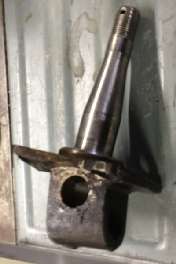
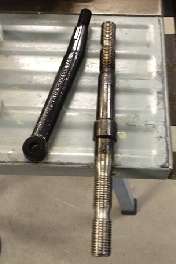
Photos added 2013.
Addendum April 1, 2019:
This assembly (re-assembly) is a lot trickier than it looks. The notch in the kingpin (swivel pin) is conical to match the conical mating end of the steering arm. As a machine design engineer, I believe the knuckle and kingpin must have been reamed with a tapered reamer in assembly to be a perfect mate to the steering arm, which locks it all tightly together. The steering arm also has a key to force correct rotational alignment of the arm to assure the steering arm (and tie rod end) will sit in correct orientation.
If you disassemble it, and then want to reassemble with the original parts, you have to be extremely careful about getting the kingpin perfectly aligned with the knuckle BEFORE pressing it together, so the conical surfaces will be properly aligned. If it is rotated even a tiny bit out of place the steering arm will not fit and seat properly.
If you want to install a new replacement swivel pin, and you think the parts might be pre-machined to match, you would be wrong. There is no way the conical surfaces could be pre-machined and achieve correct perfect alignment, due to manufacturing tolerances and the fact that original parts most likely would not all be identical in depth of the tapered reamer surfaces.
So I would advise that any time these parts are disassembled, after press fitting the swivel pin into the knuckle you should touch it with a tapered reamer to finish the conical surfaces in assembly, as the only way you could ever get the knuckle and swivel pin to line up before installing the steering arm.
The other interpretation of this assembly is that the notch in the swivel pin may be for clearance only, and does not touch the steering arm at all. Then the steering arm does not lock the swivel pin in place, but the load of the car and road abuse must be held by the press fit only. I wouldn't trust that to stay put on a rough road.
Addendum April 5, 2019:
On Apr 5, 2019 Jim Juhas in Cheshire, CT, USA wrote:
"I carefully practiced with some leftovers I had and discovered the notch in the kingpin does not come anywhere near the tapered bore surface of the steering arm hole. In fact, the kingpin can be installed within a range of at least 5 degrees without contacting the arm itself. Installation of the new pieces went without a hitch".
Addendum April 7, 2019:
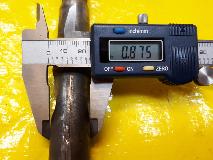
The swivel pin diameter at point of assembly with the knuckle is 7/8-inch nominal diameter.
The hole should be created with standard size reamer.
The shaft will be sligntly oversize for "force interference fit".
FN2 fit wants the hole to be 0.87500-0.87580 diameter,
and the shaft to be 0.87640-0.87690 diameter,
resulting interference to be 0.00060-0.00190 inch.
FN1 fit wants the hole to be 0.87500-0.0.87610 diameter,
and the shaft to be 0.87570-0.87690 diameter,
resulting interference to be 0.00020-0.00110 inch.
Jim Juhas has measured several original swivel pins and reports 0.8752 diameter. This would be on the loose end of light interference fit, which may be okay for large parts with long length of engagement. The swivel pin does have a shoulder on it that would prevent pull-out of the parts when under normal suspension loading. So maybe the steering arm does not have to lock the swivel pin and knuckle together.
Addendum October 10, 2021:
Here are pictures of a suspension knuckle and a new swivel pin with the notch pre-machined. This notch is deep enough to not touch the taper of the steering arm in assembly, and the flat on the shoulder collar of the pin is aligned with the notch. For assembly, align the flat parallel to the axis of the steering arm taper hole, perpendicular to the axis of the bearing spindle, and press the parts together.
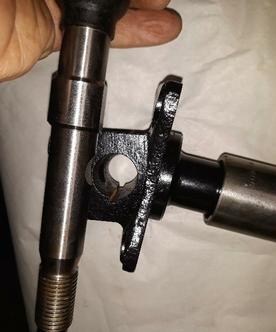
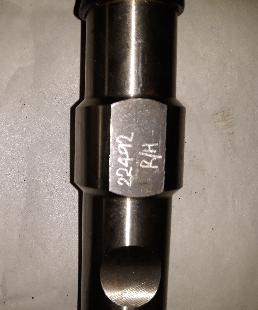
|






